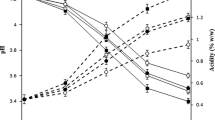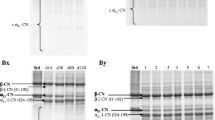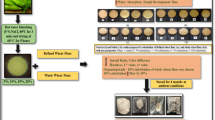Abstract
Whey, a dairy byproduct offers a challenging task in terms of its disposal. Two functional beverages were produced by blending pineapple juice with cheese whey (W1B) and paneer whey (W2B) at different concentrations (10 %, 20 % and 30 %). The beverages were compared for physico-chemical, microbial and nutraceutical properties over a period of 60 days. Whey addition significantly improved various physico-chemical parameters of the beverages. Higher protein content in W1B and a higher mineral content in W2B without any adverse effects on antioxidant activity was seen because of blending. Whey based beverages showed higher microbial content, sedimentation values and serum separation values than control at all levels of blending. Although, W1B showed highest protein and microbial count but W2B showed highest mineral content and improved shelf life due to significantly lower values of serum separation and sedimentation. It could be concluded that paneer whey based pineapple beverage enable byproduct utilization with excellent nutrition and nutraceutical quality.

Similar content being viewed by others
References
Ahmad M, Baba WN, Shah U, Gani A, Gani A, Masoodi FA (2014) Nutraceutical properties of the green tea polyphenols. J Food Process Technol 4:276. doi:10.4172/2157-7110.1000276
Ahmad M, Baba WN, Wani TA, Gani A, Gani A, Shah U, Wani SM, Masoodi FA (2015) Effect of green tea powder on thermal, rheological & functional properties of wheat flour and physical, nutraceutical & sensory analysis of cookies. J Food Sci Technol 52(9):5799–5807
Ashoush IS, El-Batawy OI, El-Shourbagy GA (2013) Antioxidant activity and hepatoprotective effect of pomegranate peel and whey powders in rats. Ann Agric Sci 58:27–32
Baba NW, Rashid I, Shah A, Ahmad M, Gani A, Masoodi FA (2014) Effect of microwave roasting on antioxidant and anti-cancerous activities of barley flour. J Saudi Soc Agric Sci. doi:10.1016/j.jssas.2014.06.003
Baccouche A, Ennouri M, Felfoul I, Attia H (2013) A physical stability study of whey-based prickly pear beverages. Food Hydrocoll 33:234–244
Baljeet SY, Ritika BY, Sarita R (2013) Studies on development of whey-based pineapple (Ananas comosus) and bottle gourd (Lagenaria siceraria) mixed herbal beverage. Int Food Res J 20:607–612
Baskar R, Shrisakthi S, Sathyapriya B, Shyampriya R, Nithya R, Poongodi P (2011) Antioxidant potential of Peel extracts of Banana Varieties (Musa sapientum). Food Nutr Sci 2:1128–1133
Benzie IIF, Strain JJ (1999) Ferric reducing antioxidant power assay: Direct measure of total antioxidant activity of biological fluids and modified version for simultaneous measurement of total antioxidant power and ascorbic acid concentration, oxidants and antioxidants. Method Enzymol 299:15–27
Cortés C, Esteve MJ, Frígola A (2008) Color of orange juice treated by high Intensity Pulsed Electric Fields during refrigerated storage and comparison with pasteurized juice. Food Control 19:151–158
De Freitas V, Carvalho E, Mateus N (2003) Study of carbohydrate influence on protein-tannin aggregation by nephelometry. Food Chem 81:503–509
Duongthingoc D, George P, Gorczyca E, Kasapis S (2014) Studies on the viability of Saccharomyces boulardii within microcapsules in relation to the thermomechanical properties of whey protein. Food Hydrocoll 42:232–238
Eissa HA, Hassanane MM, Sharaf HA (2014) Effect of Colorant on Cytogenetic, Biochemical and Histochemical parameters and quality changes during storage of some Commercial fruit drinks. J Nutr Food Sci 4:266. doi:10.4172/2155-9600.1000266
Gad AS, Emam WH, Mohamed GF, Sayd AF (2013) Utilization Whey in production of functional Healthy beverage “whey-mango beverages”. Am J Food Technol 8:133–148
Gallardo-Escamilla FJ, Kellya AL, Delahunty CM (2007) Mouthfeel and flavour of fermented whey with added hydrocolloids. Int Dairy J 17:308–315
Gani A, Baba WN, Ahmad M, Shah U, Khan AA, Wani IA, Masoodi FA, Gani A (2016). Effect of ultrasound treatment on physico-chemical, nutraceutical and microbial quality of strawberry. LWT-Food Sci Technol 66:496–502
Goyal N, Gandhi DN (2009) Comparative analysis of Indian paneer and cheese whey for electrolyte whey drink. World J Dairy Food Sci 4:70–72
Hernández-Rodríguez L, Lobato-Calleros C, Pimentel-González DJ, Vernon-Carter EJ (2014) Lactobacillus plantarum protection by entrapment in whey protein isolate: k-carrageenan complex coacervates. Food Hydrocoll 36:18–88
Hoffmann MAM, van Mil PJJM (1997) Heat-induced aggregation of β-lactoglobulin: role of the free thiol group and disulfide bonds. J Agric Food Chem 45:2942–2948
Kerasioti E, Stagos D, Priftis A, Aivazidis S, Tsatsakis AM, Hayes AW, Kouretas D (2014) Antioxidant effects of whey protein on muscle C2C12 cells. Food Chem 155:271–278
Luck G, Liao H, Murray NJ, Grimmer HR, Warminski EE, Williamson MP (1994) Polyphenols, astringency and proline-rich proteins. Phytochemistry 37:357–371
Nicolai T, Britten M, Schmitt C (2011) β-lactoglobulin and WPI aggregates: formation, structure and applications. Food Hydrocoll 25:1945–1962
Nisar R, Baba WN, Masoodi FA (2015) Effect of chemical and thermal treatments on quality parameters and antioxidant activity of apple (pulp) grown in high Himalayan regions. Cog Food Agric 1:1063797
Oranusi US, Braide W, Nezianya HO (2012) Microbiological and chemical quality assessment of ome commercially packed fruit juices sold in Nigeria. Greener J Biol Sci 2:001–006
Pan-Xun T, Durand D, Nicolai T, Donato L, Schmitt C, Bovetto L (2014) Heat induced formation of beta-lactoglobulin microgels driven by addition of calcium ions. Food Hydrocoll 34:227–235
Rahmanian N, Jafari SM, Wani TA (2015) Bioactive profile, dehydration, extraction and application of the bioactive components of olive leaves. Trends Food Sci Tech 42:150–172
Ranganna S (1986) Handbook of analysis and quality control for fruit and vegetable products. Tata McGraw-Hill Publishing Company, New Delhi, India, pp 124–125
Russell TA, Drake MA, Gerard PD (2006) Sensory properties of whey and soy proteins. J Food Sci 71:S447–S455
Ryan KN, Foegeding EA (2015) Formation of soluble whey protein aggregates and their stability in beverages. Food Hydrocoll 43:265–274
Ryan KN, Zhong Q, Foegeding EA (2012) Use of whey protein soluble aggregates for thermal Stability-A Hypothesis paper. J Food Sci 78:1105–1115
Sady M, Jaworska G, Grega T, Bernas E, Domagal J (2013) Application of acid whey in Orange drink production. Food Technol Biotechnol 51:266–277
Saxena D, Chakraborty SK, Sabikhi L, Singh D (2015) Process optimization for a nutritious low-calorie high-fiber whey-based ready-to-serve watermelon beverage. J Food Sci Technol 52:960–967
Sheraz MA, Kazi SH, Ahmed S, Anwar Z, Ahmad I (2014) Photo, thermal and chemical degradation of riboflavin. Beilstein J Org Chem 10:1999–2012
Siebert KJ (1999) Effects of protein-polyphenol interaction on beverage haze stabilization and analysis. J Agric Food Chem 47:353–362
Singleton VL, Rossi JA (1965) Colorimetry of total phenolics with phosphor molybdic phosphor tungstic acid reagent. Am J Enol Viticulture 16:144–158
Thongkaew C, Gibis M, Hinrichs J, Weiss J (2014) Polyphenol interactions with whey protein isolate and whey protein isolate-pectin coacervates. Food Hydrocoll 41:103–112
von Staszewski M, Jara FL, Ruiz ALTG, Jagus RJ, Carvalho JE, Pilosof AMR (2012) Nanocomplex formation between β-lactoglobulin or caseinomacropeptide and green tea polyphenols: Impact on protein gelation and polyphenols antiproliferative activity. J Func Foods 4:800–809
Wen-qiong W, Yi-hong B, Ying C (2013) Characteristics and antioxidant activity of water-soluble maillard reaction products from interactions in a whey protein isolate and sugars system. Food Chem 139:355–361
Acknowledgments
The author is thankful to Department of Biotechnology, Govt. of India.
Author information
Authors and Affiliations
Corresponding author
Ethics declarations
Conflict of interest
Authors have no conflict of interest.
Additional information
F. A. Masoodi is the mentor of article.
Research Highlights
• Cheese and paneer whey was blended with pineapple juice and beverages were studied for physico-chemical, antioxidant properties and storage stability for a period of 60 days. Paneer whey based beverages showed consumer acceptability up to 20 % level of addition while in cheese whey addition was acceptable only up to 10 % level of blending. This is an important implication for industrial utilization of paneer whey for beverage production.
• Antioxidant properties were studied using different assays such as DPPH, Reducing power, ABTS, FRAP and Total phenolic content.
• Storage stability was studied by serum separation, sedimentation percentage, color index (ΔE*) and microbial count.
• Both paneer as well as cheese whey based pineapple beverage showed potent antioxidant properties, high protein and mineral content that can impart status of a functional beverage to the blended beverages.
• Microbial analysis showed that Whey addition results in greater survival of microbes during storage.
Rights and permissions
About this article
Cite this article
Baba, W.N., Din, S., Punoo, H.A. et al. Comparison of cheese and paneer whey for production of a functional pineapple beverage: Nutraceutical properties and Shelf life. J Food Sci Technol 53, 2558–2568 (2016). https://doi.org/10.1007/s13197-016-2218-8
Revised:
Accepted:
Published:
Issue Date:
DOI: https://doi.org/10.1007/s13197-016-2218-8




